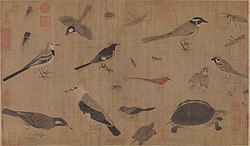History of biology
| Part of a series on |
| Biology |
|---|
 |
|
Key components
|
|
Branches
Lua error in package.lua at line 80: module 'Module:Transcluder' not found.
|
|
Applications
|
The history of biology covers the study of the living world from ancient to modern times. People began to think about biology as a specific field in the 1800s. Medicine and natural history came first. Specifics Ayurveda, ancient Egyptian medicine, and the works of Aristotle, Theophrastus and Galen in the ancient Greco-Roman world. In the Middle Ages, Muslim physicians and scholars such as Avicenna continued to develop the field.
The European Renaissance changed biology because people discovered new organisms and began to think more scientifically, using Empiricism. Important scientists related to this change were Vesalius and Harvey in physiology and Linnaeus and Buffon in natural history. Antonie van Leeuwenhoek used a microscope to reveal microorganisms. His work would lead to cell theory.
In the 1700s and 1800s, many specific fields related to biology developed. Botany and zoology were the first to fully develop. Biogeography, ecology, ethology, embryology, and paleontology also started to build. Charles Darwin's theory of evolution by natural selection brought many of these ideas together. People stopped believing in spontaneous generation. In medicine, people started to believe in the germ theory of disease.
Around 1900, big change happened in genetics. Carl Correns found work by Gregor Mendel on genetics pea plants. Then Thomas Hunt Morgan and his students applied Mendel's work to fruit flies. By the 1930s, population genetics were studied with natural selection in the "neo-Darwinian synthesis". In 1953, Watson and Crick explained the structure of DNA. Other big developments in the 1900s included the Central Dogma and understanding the genetic code and its rules.
Now, biology is separated into different fields, or subjects. The main fields are organismal biology, cell biology, and molecular biology.
History Of Biology Media
Clay models of animal livers dating between the nineteenth and eighteenth centuries BCE, found in the royal palace at Mari
Description of rare animals (写生珍禽图), by Huang Quan (903–965) during the Song dynasty
Frontispiece to a 1644 version of the expanded and illustrated edition of Historia Plantarum, originally written by Theophrastus around 300 BCE
A biomedical work by Ibn al-Nafis, an early adherent of experimental dissection who discovered the pulmonary and coronary circulation
De arte venandi, by Frederick II, Holy Roman Emperor, was an influential medieval natural history text that explored bird morphology.
Cabinets of curiosities, such as that of Ole Worm, were centers of biological knowledge in the early modern period, bringing organisms from across the world together in one place. Before the Age of Exploration, naturalists had little idea of the sheer scale of biological diversity.
In Micrographia, Robert Hooke had applied the word cell to biological structures such as this piece of cork, but it was not until the 19th century that scientists considered cells the universal basis of life.
In the course of his travels, Alexander von Humboldt mapped the distribution of plants across landscapes and recorded a variety of physical conditions such as pressure and temperature.
Charles Darwin's first sketch of an evolutionary tree from his First Notebook on Transmutation of Species (1837)







